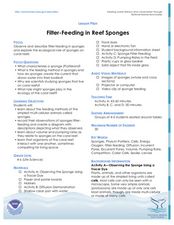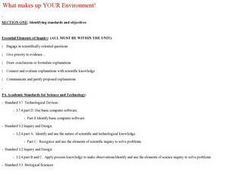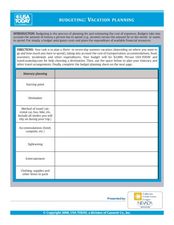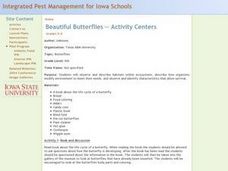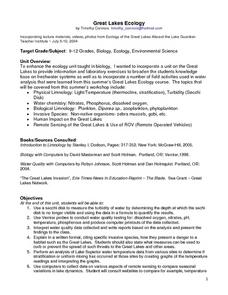Curated OER
Dissecting Owl Pellets
Students explore owl pellets. In this animal science lesson, students use owl pellet dissection kits to dissect one owl pellet. Students use a magnifying glass to identify the foods that the owl ate.
Curated OER
Filter Feeding in Reef Sponges
Students investigate the role of sponges in our oceans. In this biology instructional activity, students create a diagram visualizing how sponges bring food into their bodies through a filtering process. Students discuss the...
Curated OER
Family Tree
Young scholars create a family tree in this culminating activity to their family unit. In this family tree lesson, students extend their learning about the family unit by working in small groups to develop a three generation family tree....
Curated OER
Worm Composting
Second graders discuss worm composting. In this decomposition lesson plan, 2nd graders look at the anatomy of the worm and how it eats food. They have their own worm bin and review what foods can and can not be given to the worms for...
Curated OER
Web of Life - Role-Playing
Students role-play how organisms adapt to their environment. They play 20 questions with plant and animal habitats. They create a web of life to demonstrate how each plant and animal relies on the other for survival.
Curated OER
Marine & Aquatic Habitats Activities - Aquatic Animals
Students explore importance of marine or aquatic habitats, and investigate habitat characteristics and conditions required by various organisms to ensure survival. They then select an animal to study and design an artificial habitat...
Curated OER
Environmental Health Hazards and Children
Students are introduced to the environmental hazards their community is facing. In groups, they develop a list of the ways humans have changed the Earth and how these changes have lead to environmental hazards. They record their...
Curated OER
Plants, Animals and Our Environment
Students draw and label the basic needs of animals. They draw and label the basic needs of plants. Students understand the basic needs of plants and animals are not only the same, but are interrelated. They know that the environment...
Curated OER
What makes up YOUR Environment!
Middle schoolers create their own land or water environment. They make their environment livable for all the different animals they collect to put in it. Students research the types of animals that they can have in their environment,...
Curated OER
Ecosystem Interdependence
Students outline a scenario demonstrating ecosystem interdependence. They explain the effects of this change according to the food web. They give a positive example such as increased rain and have the students call out answers to your...
Curated OER
Calling All Fruits And Vegetables!
Students differentiate between fruits and vegetables. They identify 20-25 common fruits and vegetables and utilize the Internet to gather and organize information about fruits and vegetables. Afterward, they create a new fruit and...
Curated OER
Dinosaurs
Students participate in a simulated archeological dig to gain an understanding of the earth's development as well as the organisms on it. In this dinosaur lesson plan, students work in small groups removing five pieces from the 'dig' one...
Curated OER
Budgeting: Vacation Planning
In this vacation planning worksheet, students plan a vacation. They determine the approximate cost of their vacation. Students complete an itenrary and graphic organizer to identify daily costs of the vacation. This two-page...
Curated OER
Beautiful Butterflies - Activity Centers
Students describe habitats within ecosystems, describe how organisms modify environment to meet their needs, and identify characteristics for butterfly survival. In this butterfly lesson plan, students explore all aspects of the...
Curated OER
Structural and Behavioral Adaptations
Students participate in a role playing lab that allows students to experience how different beak adaptations play a role in the type of food the animal can eat, therefore playing a role in the survival of the species.
Curated OER
Great Lakes Ecology
Eighth graders identify the Great Lakes, and describe the habitat of life of a loon. They are able to point to and explain one of the major river systems that enters the Great Lakes with a focus on the Clinton River and the food webs...
Curated OER
Life Systems - Plant Growth
3rd graders will participate in a variety of tasks which help them to understand the basic concepts of plant growth. Research and reporting skills are developed as they gather information from various sources related to the use of plants...
Curated OER
Lesson 1: Identifying Information
Factual books about animals are great for sparking interest in non-fiction text. Little ones will love learning about the foods animals eat as they practice identifying facts in a text. They chart the information they've learned by...
Curated OER
Freshwater/Saltwater "Eggs-Periment"
Students explore water properties by conducting a class experiment. For this buoyancy lesson, students utilize freshwater, saltwater, plastic cups, hard boiled eggs and food coloring to experiment with the floating capabilities of salt...
Curated OER
Reviving Celery
The classic in-class demonstration using celery dipped into water with food coloring is the highlight of this biology lesson plan. Young scientists discover that organisms are made up cells and have distinguishing characteristics. After...
Curated OER
Chesapeake Bay
The Chesapeake Bay is the largest estuary in the United States. Explore its origins, organisms, and contributing rivers with this PowerPoint. It opens with several slides of general information on the formation of estuaries, then it...
Curated OER
KWL Chart
In this KWL chart worksheet, students fill out a graphic organizer about what they know, what they want to know, and what they learned about a given subject.
Curated OER
Monthly Cost of Living Grocery List
In this economics worksheet, 4th graders find the cost of grocery items and compute the total cost per month for buying them in the graphic organizer.
Curated OER
What is a Living Thing?
In this living things worksheet, students complete a graphic organizer by filling in statements describing the characteristics of living things.
Other popular searches
- Con Pair Organic Foods
- Organic Foods Taste
- Non Organic Foods
- Com Pair Organic Foods
- California Organic Foods
- Compair Organic Foods
- Conpair Organic Foods
- Organic Foods Lesson Plan



